Carbohydrate Derived Organogelators and the Corresponding Functional Gels Developed in Recent Time
Abstract
:1. Introduction
2. Carbohydrate Derived Low Molecular Weight Gelators
2.1. Importance of Carbohydrates as Renewable Resources in This Field
2.2. Gelators Utilizing Renewable Sugar Resources
2.2.1. Gelators Based on Alditols
2.2.2. Gelators Based on Monosaccharides and Disaccharides
2.2.3. Gelators Incorporating the Triazole Moiety to Sugar by Click Chemistry
2.2.4. Miscellaneous
3. Applications
3.1. Stimuli Responsive Organogels
3.2. Phase Selective Gels and Some Selected Application Toward Oil-Spill Removal and Recovery
3.3. Drug Binding and Their Controlled Release
3.4. Sol-Gel Transcription
3.5. Chirality of Resin
3.6. Semiconductor Fabric
3.7. Lectin Binding
3.8. Self-Healing Property
3.9. Structuring Agent
3.10. Medium for Enzyme Catalysis
4. Conclusions and Future Perspectives
Author Contributions
Acknowledgments
Conflicts of Interest
References
- Lehn, J.M. Supramolecular Chemistry: Concepts and Perspectives; VCH: Weinheim, Germany, 1995. [Google Scholar]
- Lehn, J.M. Perspectives in supramolecular chemistry—From Molecular recognition towards molecular information pro cessing and self-organization. Angew. Chem. Int. Ed. Engl. 1990, 29, 1304–1319. [Google Scholar] [CrossRef]
- Lloyd, J. The problem of gel structure. Colloid Chem. 1926, 1, 767–782. [Google Scholar]
- Térech, P. Materials with self-assembled fibrillar networks. In Molecular Gels; Térech, P., Weiss, R.G., Eds.; Springer: Dordrecht, The Netherlands, 2006. [Google Scholar]
- Sangeetha, N.M.; Maitra, U. Supramolecular gels: Functions and uses. Chem. Soc. Rev. 2005, 34, 821–836. [Google Scholar] [CrossRef] [PubMed]
- George, M.; Weiss, G.R. Molecular organogels. Soft matter comprised of low-molecular-mass organic gelators and organic liquids. Acc. Chem. Res. 2006, 39, 489–497. [Google Scholar] [CrossRef] [PubMed]
- Osada, Y.; Kajiwara, K.; Fushimi, T.; Hirasa, O.; Hirokawa, Y.; Matsunaga, T.; Shimomura, T.; Wang, L.; Ishida, H. Gels Handbook; Academic Press: San Diego, CA, USA, 2001; Volumes 1–3. [Google Scholar]
- De Loos, M.; Feringa, B.L.; van Esch, J.H. Design and application of self-assembled low molecular weight hydrogels. Eur. J. Org. Chem. 2005, 2005, 3615–3631. [Google Scholar] [CrossRef]
- Guenet, J.-M. Thermoreversible Gelation of Polymers and Biopolymers; Academic Press: London, UK, 1992. [Google Scholar]
- Estroff, L.A.; Hamilton, A.D. Water gelation by small organic molecules. Chem. Rev. 2004, 104, 1201–1218. [Google Scholar] [CrossRef] [PubMed]
- Murdan, S. Organogels in drug delivery. Expert Opin. Drug Deliv. 2005, 2, 489–505. [Google Scholar] [CrossRef] [PubMed]
- Du, X.; Zhou, J.; Shi, J.; Xu, B. Supramolecular hydrogelators and hydrogels: from soft matter to molecular biomaterials. Chem. Rev. 2015, 115, 13165–13307. [Google Scholar] [CrossRef] [PubMed]
- Vemula, P.K.; Aslam, U.; Ajay Mallia, V.; John, G. In Situ Synthesis of gold nanoparticles using molecular gels and liquid crystals from vitamin-C amphiphiles. Chem. Mater. 2007, 19, 138–140. [Google Scholar] [CrossRef]
- Terech, P.; Weiss, R.G. Low molecular mass gelators of organic liquids and the properties of their gels. Chem. Rev. 1997, 97, 3133–3160. [Google Scholar] [CrossRef] [PubMed]
- Zhao, F.; Ma, M.L.; Xu, B. Molecular hydrogels of therapeutic agents. Chem. Soc. Rev. 2009, 38, 883–891. [Google Scholar] [CrossRef] [PubMed]
- Dastidar, P. Supramolecular gelling agents: Can they be designed? Chem. Soc. Rev. 2008, 37, 2699–2715. [Google Scholar] [CrossRef] [PubMed]
- Banerjee, S.; Das, R.K.; Maitra, U. Supramolecular gels ‘in action’. J. Mater. Chem. 2009, 19, 6649–6687. [Google Scholar] [CrossRef]
- Piepenbrock, M.O.M.; Lloyd, G.O.; Clarke, N.; Steed, J.W. Metal- and anion-binding supramolecular gels. Chem. Rev. 2010, 110, 1960–2004. [Google Scholar] [CrossRef] [PubMed]
- Gao, Y.; Zhao, F.; Wang, Q.; Zhang, Y.; Xu, B. Small peptide nanofibers as the matrices of molecular hydrogels for mimicking enzymes and enhancing the activity of enzymes. Chem. Soc. Rev. 2010, 39, 3425–3433. [Google Scholar] [CrossRef] [PubMed]
- Das, D.; Kar, T.; Das, P.K. Gel-nanocomposites: Materials with promising applications. Soft Matter 2012, 8, 2348–2365. [Google Scholar] [CrossRef]
- Adarsh, N.N.; Dastidar, P. Coordination polymers: What has been achieved in going from innocent 4,4′-bipyridine to bis-pyridyl ligands having a non-innocent backbone? Chem. Soc. Rev. 2012, 41, 3039–3060. [Google Scholar] [CrossRef] [PubMed]
- Appel, E.A.; del Barrio, J.; Loh, X.J.; Scherman, O.A. Supramolecular polymeric hydrogels. Chem. Soc. Rev. 2012, 41, 6195–6214. [Google Scholar] [CrossRef] [PubMed]
- Balachandran, V.S.; Jadhav, S.R.; Vemula, P.K.; John, G. Recent advances in cardanol chemistry in a nutshell: From a nut to nanomaterials. Chem. Soc. Rev. 2013, 42, 427–438. [Google Scholar] [CrossRef] [PubMed]
- Jung, J.H.; Lee, J.H.; Silverman, J.R.; John, G. Coordination polymer gels with important environmental and biological applications. Chem. Soc. Rev. 2013, 42, 924–936. [Google Scholar] [CrossRef] [PubMed]
- Raeburn, J.; Cardoso, A.Z.; Adams, D.J. The importance of the self-assembly process to control mechanical properties of low molecular weight hydrogels. Chem. Soc. Rev. 2013, 42, 5143–5156. [Google Scholar] [CrossRef] [PubMed]
- Boekhoven, J.; Stupp, S.I. 25th Anniversary article: Supramolecular materials for regenerative medicine. Adv. Mater. 2014, 26, 1642–1659. [Google Scholar] [CrossRef] [PubMed]
- Datta, S.; Bhattacharya, S. Multifarious facets of sugar-derived molecular gels: Molecular features, mechanisms of self-assembly and emerging applications. Chem. Soc. Rev. 2015, 44, 5596–5637. [Google Scholar] [CrossRef] [PubMed]
- Guenet, J.-M. Organogels: Thermodynamics, Structure, Solvent Role and Properties; Springer: New York, NY, USA, 2016. [Google Scholar]
- Menger, F.M.; Caran, K.L. Anatomy of a gel. Amino acid derivatives that rigidify water at submillimolar concentrations. J. Am. Chem. Soc. 2000, 122, 11679–11691. [Google Scholar]
- Estroff, L.A.; Hamilton, A.D. Effective gelation of water using a series of bis-urea dicarboxylic acids. Angew. Chem. Int. Ed. Engl. 2000, 39, 3447–3450. [Google Scholar] [CrossRef]
- Fuhrhop, J.H.; Schnieder, P.; Rosenberg, J.; Boekema, E. The chiral bilayer effect stabilizes micellar fibers. J. Am. Chem. Soc. 1987, 109, 3387–3390. [Google Scholar] [CrossRef]
- Abdallah, D.J.; Weiss, R.G. n-Alkanes gel n-alkanes (and many other organic liquids). Langmuir 2000, 16, 352–355. [Google Scholar] [CrossRef]
- Lan, Y.; Corradini, M.G.; Weiss, R.G.; Raghavanc, S.R.; Rogers, M.A. To gel or not to gel: Correlating molecular gelation with solvent parameters. Chem. Soc. Rev. 2015, 44, 6035–6058. [Google Scholar] [CrossRef] [PubMed]
- Hollingsworth, R.I.; Wang, G. Toward a carbohydrate-based chemistry: Progress in the development of general-purpose chiral synthons from carbohydrates. Chem. Rev. 2000, 100, 4267–4282. [Google Scholar] [CrossRef] [PubMed]
- Meunier, M.J. Sur Les Composés Que La Mannite et La Sorbite Forment Avec Les Aldéhydes. Ann. Chim. Phys. 1891, 22, 412–432. [Google Scholar]
- Angyal, S.J.; Lawler, J.V. 1,3:2,4-Dibenzylidene-d-sorbitol. J. Am. Chem. Soc. 1944, 66, 837–838. [Google Scholar] [CrossRef]
- Yamasaki, S.; Tsutsumi, H. Microscopic Studies of 1,3:2,4-Di-O-benzylidene-d-sorbitol in ethylene glycol. Bull. Chem. Soc. Jpn. 1994, 67, 906–911. [Google Scholar] [CrossRef]
- Hosoda, A.; Miyake, Y.; Nomura, E.; Taniguchi, H. Organogel formation of optically active 1,6-di-O-TIPDS-myo-inositol. Chem. Lett. 2003, 32, 1042–1043. [Google Scholar] [CrossRef]
- Watanabe, Y.; Miyasou, T.; Hayashi, M. Diastereomixture and racemate of myo-inositol derivatives, stronger organogelators than the corresponding homochiral isomers. Org. Lett. 2004, 6, 1547–1550. [Google Scholar] [CrossRef] [PubMed]
- Jung, J.H.; Shinkai, S.; Shimizu, T. Spectral characterization of self-assemblies of aldopyranoside amphiphilic gelators: What is the essential structural difference between simple amphiphiles and bolaamphiphiles? Chem. Eur. J. 2002, 8, 2684–2690. [Google Scholar] [CrossRef]
- Shimizu, T.; Masuda, M. Stereochemical Effect of even-odd connecting links on supramolecular assemblies made of 1-glucosamide bolaamphiphiles. J. Am. Chem. Soc. 1997, 119, 2812–2818. [Google Scholar] [CrossRef]
- Hafkamp, R.J.H.; Feiters, M.C.; Nolte, R.J.M. Organogels from carbohydrate amphiphiles. J. Org. Chem. 1999, 64, 412–426. [Google Scholar] [CrossRef]
- Amanokura, N.; Yoza, K.; Shinmori, H.; Shinkai, S.; Reinhoudt, D.N. New sugar-based gelators bearing a p-nitrophenyl chromophore: Remarkably large influence of a sugar structure on the gelation ability. J. Chem. Soc. Perkin Trans. 1998, 2, 2585–2592. [Google Scholar] [CrossRef]
- Jung, J.H.; Ono, Y.; Hanabusa, K.; Shinkai, S. Creation of both right-handed and left-handed silica structures by sol-gel transcription of organogel fibers comprised of chiral diaminocyclohexane derivatives. J. Am. Chem. Soc. 2000, 122, 5008–5009. [Google Scholar] [CrossRef]
- Gronwald, O.; Shinkai, S. Sugar-integrated gelators of organic solvents. Chem. Eur. J. 2001, 7, 4328–4334. [Google Scholar] [CrossRef]
- Snip, E.; Koumoto, K.; Shinkai, S. Gel formation properties of a uracil-appended cholesterol gelator and cooperative effects of the complementary nucleobases. Tetrahedron 2002, 58, 8863–8873. [Google Scholar] [CrossRef]
- Friggeri, A.; Gronwald, O.; van Bommel, K.J.C.; Shinkai, S.; Reinhoudt, D.N. Charge-transfer phenomena in novel, dual-component, sugar-based organogels. J. Am. Chem. Soc. 2002, 124, 10754–10758. [Google Scholar] [CrossRef] [PubMed]
- Fujita, N.; Shinkai, S. Design and function of low molecular-mass organic gelators (LMOGs) bearing steroid and sugar groups. In Molecular Gels; Springer: Dordrecht, The Netherlands, 2006; pp. 553–575. [Google Scholar]
- Vemula, P.K.; Li, J.; John, G. Enzyme catalysis: Tool to make and break amygdalin hydrogelators from renewable resources: A delivery model for hydrophobic drugs. J. Am. Chem. Soc. 2006, 128, 8932–8938. [Google Scholar] [CrossRef] [PubMed]
- Yang, Z.; Liang, G.; Ma, M.; Abbah, A.S.; Lu, W.W.; Xu, B.D. d-Glucosamine-based supramolecular hydrogels to improve wound healing. Chem. Commun. 2007, 843–845. [Google Scholar] [CrossRef] [PubMed]
- Okesola, B.O.; Vieira, V.M.P.; Cornwell, D.J.; Whitelaw, N.K.; Smith, D.K. 1,3:2,4-Dibenzylidene-d-sorbitol (DBS) and its derivatives—Efficient, versatile and industrially relevant low-molecular-weight gelators with over 100 years of history and a bright future. Soft Matter 2015, 11, 4768–4787. [Google Scholar] [CrossRef] [PubMed]
- Takeno, H.; Kuribayashi, Y. A synchrotron small-angle X-ray scattering study on structures of 1,3:2,4-dibenzylidene sorbitol gels. Colloids Surf. A Physicochem. Eng. Asp. 2015, 467, 173–179. [Google Scholar] [CrossRef]
- Lai, W.-C.; Huang, P.-H. Self-assembly behaviors of dibenzylidene sorbitol hybrid organogels with inorganic silica. Soft Matter 2017, 13, 3107–3115. [Google Scholar] [CrossRef] [PubMed]
- Lai, W.-C.; Tseng, S.-J.; Huang, P.-H. Self-assembled structures of 1,3:2,4-di(3,4-dimethylbenzylidene) sorbitol in hydrophobic polymer matrices prepared using different heat treatments. J. Nanopart. Res. 2015, 17, 456–457. [Google Scholar] [CrossRef]
- Lai, W.-C. The effect of self-assembled nanofibrils on the morphology and microstructure of poly(l-lactic acid). Soft Matter 2011, 7, 3844–3851. [Google Scholar] [CrossRef]
- Singh, A.; Auzanneau, F.-I.; Corradini, M.G.; Grover, G.; Weiss, R.G.; Rogers, M.A. Molecular nuances governing the self-assembly of 1,3:2,4-dibenzylidene-d-sorbitol. Langmuir 2017, 33, 10907–10916. [Google Scholar] [CrossRef] [PubMed]
- Singh, V.K.; Pramanik, K.; Ray, S.S.; Pal, K. Development and characterization of sorbitan monostearate and sesame oil-based organogels for topical delivery of antimicrobials. AAPS Pharmscitech 2015, 16, 293–305. [Google Scholar] [CrossRef] [PubMed]
- Sagiri, S.S.; Kasiviswanathan, U.; Shaw, G.S.; Singh, M.; Anis, A.; Pal, K. Effect of sorbitan monostearate concentration on the thermal, mechanical and drug release properties of oleogels. Korean J. Chem. Eng. 2016, 33, 1720–1727. [Google Scholar] [CrossRef]
- McNeice, P.; Zhao, Y.; Wang, J.; Donnelly, G.F.; Marr, P.C. Low molecular weight gelators (LMWGs) for ionic liquids: The role of hydrogen bonding and sterics in the formation of stable low molecular weight ionic liquid gels. Green Chem. 2017, 19, 4690–4697. [Google Scholar] [CrossRef]
- Raju, C.S.K.; Pramanik, B.; Ravishankar, R.; Rao, P.V.C.; Sriganesh, G. Xylitol based phase selective organogelators for potential oil spillage recovery. RSC Adv. 2017, 7, 37175–37180. [Google Scholar] [CrossRef]
- Rajkamal, R.; Pathak, N.P.; Halder, T.; Dhara, S.; Yadav, S. Partially acetylated or benzoylated arabinose derivatives as structurally simple organogelators: Effect of the ester protecting group on gel properties. Chem. Eur. J. 2017, 23, 11323–11329. [Google Scholar] [CrossRef] [PubMed]
- Ono, F.; Hirata, O.; Ichimaru, K.; Saruhashi, K.; Watanabe, H.; Shinkai, S. Mild one-step synthesis of 4,6-benzylideneglycopyranosides from aromatic aldehydes and gelation abilities of the glucose derivatives. Eur. J. Org. Chem. 2015, 2015, 6439–6447. [Google Scholar] [CrossRef]
- Kowalczuk, J. The structural parameters of rigid matrix of saccharide based gel described by short and long diffusion regime analysis. J. Mater. Sci. 2017, 52, 11101–11108. [Google Scholar] [CrossRef]
- Mukherjee, S.; Rama Krishna, G.; Mukhopadhyay, B.; Malla Reddy, C. A correlation study between hydrogen-bonded network and gelation ability of three galactose derivatives. CrystEngComm 2015, 17, 3345–3353. [Google Scholar] [CrossRef]
- Luboradzki, R.; Gronwald, O.; Ikeda, M.; Shinkai, S.; Reinhoudt, D.N. An attempt to predict the gelation ability of hydrogen-bond-based gelators utilizing a glycoside library. Tetrahedron 2000, 56, 9595–9599. [Google Scholar] [CrossRef]
- Pal, K.B.; Mukhopadhyay, B. Carbohydrate-based safe fuel gel with significant self–healing property. Chem. Sel. 2017, 2, 967–974. [Google Scholar]
- Mitra, A.; Sarkar, V.; Mukhopadhyay, B. Simple carbohydrate-derived multifunctional gels. Chem. Sel. 2017, 2, 9958–9961. [Google Scholar] [CrossRef]
- Xu, Z.; Zhang, Y.; Zhao, K.; Li, Y.; Yu, X. Morphology transformation between nanofibres and vesicles controlled by ultrasound and heat in tryptamine-based assembly. Supramol. Chem. 2016, 28, 865–869. [Google Scholar] [CrossRef]
- Narayana, C.; Upadhyay, R.K.; Chaturvedi, R.; Sagar, R. A versatile carbohydrate based gelator for oil water separation, nanoparticle synthesis and dye removal. New J. Chem. 2017, 41, 2261–2267. [Google Scholar] [CrossRef]
- Chen, A.; Adhikari, S.B.; Mays, K.; Wang, G. Synthesis and study of molecular assemblies formed by 4,6-O-(2-phenylethylidene)-functionalized d-glucosamine derivatives. Langmuir 2017, 33, 8076–8089. [Google Scholar] [CrossRef] [PubMed]
- Krishnamoorthy, L.; Kandasamy, G.; Yadavali, S.P.; Rajendhiran, S.; Thamizhanban, A.; Maheswari, C.U.; Vellaisamy, S.; Subbiah, N. Supramolecular gel formation based on glycolipids derived from renewable resources. Gels 2018, 4, 1. [Google Scholar] [CrossRef]
- Liu, J.; Xu, F.; Sun, Z.; Pan, Y.; Tian, J.; Linc, H.-C.; Li, X. A supramolecular gel based on a glycosylated amino acid derivative with the properties of gel to crystal transition. Soft Matter 2016, 12, 141–148. [Google Scholar] [CrossRef] [PubMed]
- Himabindu, M.; Palanisamy, A. Ultrasound- and temperature-induced gelation of gluconosemicarbazide gelator in DMSO and water mixtures. Gels 2017, 3, 12. [Google Scholar] [CrossRef]
- Soundarajan, K.; Periyasamy, R.; Mohan Das, T. Design and synthesis of sugar-benzohydrazides: Low molecular weight organogelators. RSC Adv. 2016, 6, 81838–81846. [Google Scholar] [CrossRef]
- Mangunuru, H.P.R.; Yerabolu, J.R.; Liu, D.; Wang, G. Synthesis of a series of glucosyl triazole derivatives and their self-assembling properties. Tetrahedron Lett. 2015, 56, 82–85. [Google Scholar] [CrossRef]
- Mangunuru, H.P.R.; Yerabolu, J.R.; Wang, G. Synthesis and study of N-acetyl d-glucosamine triazole derivatives as effective low molecular weight gelators. Tetrahedron Lett. 2015, 56, 3361–3364. [Google Scholar] [CrossRef]
- Okafor, I.S.; Wang, G. Synthesis and gelation property of a series of disaccharide triazole derivatives. Carbohydr. Res. 2017, 451, 81–94. [Google Scholar] [CrossRef] [PubMed]
- Wang, G.; Chen, A.; Mangunuru, H.P.R.; Yerabolu, J.R. Synthesis and characterization of amide linked triazolyl glycolipids as molecular hydrogelators and organogelators. RSC Adv. 2017, 7, 40887–40895. [Google Scholar] [CrossRef]
- Chen, A.; Okafor, I.; Garcia, C.; Wang, G. Synthesis and self-assembling properties of 4,6-benzylidiene acetal protected d-glucose and d-glucosamine β–1,2,3–triazole derivatives. Carbohydr. Res. 2018, 461, 60–75. [Google Scholar] [CrossRef] [PubMed]
- Fitremann, J.; Lonetti, B.; Fratini, E.; Fabing, I.; Payré, B.; Boulé, C.; Loubinoux, I.; Vaysse, L.; Oriol, L. A shear-induced network of aligned wormlike micelles in a sugar-based molecular gel. From gelation to biocompatibility assays. J. Colloid Interface Sci. 2017, 504, 721–730. [Google Scholar] [CrossRef] [PubMed]
- Tyagi, M.; Taxak, N.; Bharatam, P.V.; Nandanwar, H.; Ravindranathan Kartha, K.P. Mechanochemical click reaction as a tool for making carbohydrate based triazole-linked self-assembling materials (CTSAMs). Carbohydr. Res. 2015, 407, 137–147. [Google Scholar] [CrossRef] [PubMed]
- Latxague, L.; Ramin, M.A.; Appavoo, A.; Berto, P.; Maisani, M.; Ehret, C.; Chassande, O.; Barthélémy, P. Control of stem-cell behavior by fine tuning the supramolecular assemblies of low-molecular-weight gelators. Angew. Chem. Int. Ed. 2015, 54, 4517–4521. [Google Scholar] [CrossRef] [PubMed]
- Ramin, M.A.; Baillet, J.; Benizri, S.; Latxague, L.; Barthélémy, P. Uracile based glycosyl-nucleoside-lipids as low molecular weight organogelators. New J. Chem. 2016, 40, 9903–9906. [Google Scholar] [CrossRef]
- Wang, T.; Wang, Z.; Xie, D.; Wang, C.; Zhen, X.; Li, Y.; Yu, X. Ultrasound accelerated sugar based gel for in situ construction of a Eu3+-based metallogel via energy transfer in a supramolecular scaffold. RSC Adv. 2015, 5, 107694–107699. [Google Scholar] [CrossRef]
- Wang, X.; Hao, J. Ionogels of sugar surfactant in ethylammonium nitrate: Phase transition from closely packed bilayers to right-handed twisted ribbons. J. Phys. Chem. B 2015, 119, 13321–13329. [Google Scholar] [CrossRef] [PubMed]
- Vidyasagar, A.; Sureshan, K.M. Stoichiometric sensing to opt between gelation and crystallization. Angew. Chem. Int. Ed. 2015, 54, 12078–12082. [Google Scholar] [CrossRef] [PubMed]
- Suzuki, M.; Uematsu, H.; Hanabusa, K. Novel organogelators based on phytosphingosine. Tetrahedron Lett. 2016, 57, 2807–2810. [Google Scholar] [CrossRef]
- Draper, E.R.; Adams, D.J. Photoresponsive gelators. Chem. Commun. 2016, 52, 8196–8206. [Google Scholar] [CrossRef] [PubMed]
- Nagasawa, J.; Kudo, M.; Hayashi, S.; Tamaoki, N. Organogelation of diacetylene cholesteryl esters having two urethane linkages and their photopolymerization in the gel state. Langmuir 2004, 20, 7907–7916. [Google Scholar] [CrossRef] [PubMed]
- Hsu, L.; Cvetanovich, G.L.; Stupp, S.I. Peptide amphiphile nanofibers with conjugated polydiacetylene backbones in their core. J. Am. Chem. Soc. 2008, 130, 3892–3899. [Google Scholar] [CrossRef] [PubMed]
- Jung, S.H.; Lee, H.; Han, W.S.; Jung, J.H. The effect of hydrogen-bonds of amino acid-derived diacetylene by photopolymerization in supramolecular hydrogels. J. Nanosci. Nanotechnol. 2011, 11, 2113–2120. [Google Scholar] [CrossRef] [PubMed]
- Rondeau-Gagne, S.; Neabo, J.R.; Desroches, M.; Larouche, J.; Brisson, J.; Morin, J.-F. Topochemical polymerization of phenylacetylene macrocycles: A new strategy for the preparation of organic nanorods. J. Am. Chem. Soc. 2013, 135, 110–113. [Google Scholar] [CrossRef] [PubMed]
- Wang, J.; Yang, G.; Jiang, H.; Zou, G.; Zhang, Q. Photo-responsive cholesterol-substituted diacetylenic organogels: Morphology tuning, photo-switching and photo-polymerization. Soft Matter 2013, 9, 9785–9791. [Google Scholar] [CrossRef]
- Sun, X.; Chen, T.; Huang, S.; Li, L.; Peng, H. Chromatic polydiacetylene with novel sensitivity. Chem. Soc. Rev. 2010, 39, 4244–4257. [Google Scholar] [CrossRef] [PubMed]
- Schott, M. The colors of polydiacetylenes: A commentary. J. Phys. Chem. B 2006, 110, 15864–15868. [Google Scholar] [CrossRef] [PubMed]
- Fujita, N.; Sakamoto, Y.; Shirakawa, M.; Ojima, M.; Fujii, A.; Ozaki, M.; Shinkai, S. Polydiacetylene nanofibers created in low-molecular-weight gels by post modification: Control of blue and red phases by the odd-even effect in alkyl chains. J. Am. Chem. Soc. 2007, 129, 4134–4135. [Google Scholar] [CrossRef] [PubMed]
- Filhol, J.-S.; Deschamps, J.; Dutremez, S.G.; Boury, B.; Barisien, T.; Legrand, L.; Schott, M. Polymorphs and colors of polydiacetylenes: A first principles study. J. Am. Chem. Soc. 2009, 131, 6976–6988. [Google Scholar] [CrossRef] [PubMed]
- Assali, M.; Cid, J.-J.; Fernandez, I.; Khiar, N. Supramolecular diversity through click chemistry: Switching from nanomicelles to 1D-nanotubes and tridimensional hydrogels. Chem. Mater. 2013, 25, 4250–4261. [Google Scholar] [CrossRef]
- Wang, G.; Goyal, N.; Mangunuru, H.P.R.; Yang, H.; Cheuk, S.; Narasimha Reddy, P.V. Preparation and self-assembly study of amphiphilic and bispolar diacetylene-containing glycolipids. J. Org. Chem. 2015, 80, 733–743. [Google Scholar] [CrossRef] [PubMed]
- Clemente, M.J.; Tejedor, R.M.; Romero, P.; Fitremann, J.; Oriol, L. Photoresponsive supramolecular gels based on amphiphiles with azobenzene and maltose or polyethyleneglycol polar head. New J. Chem. 2015, 39, 4009–4019. [Google Scholar] [CrossRef]
- Guan, X.; Fan, K.; Gao, T.; Ma, A.; Zhang, B.; Song, J. A novel multi-stimuli responsive gelator based on d-gluconic acetal and its potential applications. Chem. Commun. 2016, 52, 962–965. [Google Scholar] [CrossRef] [PubMed]
- Lin, C.; Maisonneuve, S.; Métivier, R.; Xie, J. Photoswitchable carbohydrate-based macrocyclic azobenzene: Synthesis, chiroptical switching, and multistimuli-responsive self-assembly. Chem. Eur. J. 2017, 23, 14996–15001. [Google Scholar] [CrossRef] [PubMed]
- Nuthanakanti, A.; Srivatsan, S.G. Hierarchical self-assembly of switchable nucleolipid supramolecular gels based on environmentally-sensitive fluorescent nucleoside analogs. Nanoscale 2016, 8, 3607–3619. [Google Scholar] [CrossRef] [PubMed]
- Nuthanakanti, A.; Srivatsan, S.G. Surface-tuned and metal-ion-responsive supramolecular gels based on nucleolipids. ACS Appl. Mater. Interfaces 2017, 9, 22864–22874. [Google Scholar] [CrossRef] [PubMed]
- Jia, X.; Zhao, J.; Xu, S.; Zhang, F.; Sun, J.; Lu, R. Luminescent organogels generated from nucleosides functionalized with carbazole: Synthesis and probing for F−1. Eur. J. Org. Chem. 2018. [Google Scholar] [CrossRef]
- Motta, F.L.; Stoyanov, S.R.; Soares, J.B.P. Application of solidifiers for oil spill containment: A review. Chemosphere 2018, 194, 837–846. [Google Scholar] [CrossRef] [PubMed]
- Pathak, N.P.; Chatterjee, D.; Paul, A.; Yadav, S. Arabinose based gelators: Rheological characterization of the gels and phase selective organogelation of crude-oil. RSC Adv. 2016, 6, 92225–92234. [Google Scholar]
- Wang, D.; Niu, J.; Wang, Z.; Jin, J. Monoglyceride-Based Organogelator for Broad-Range Oil Uptake with High Capacity. Langmuir 2015, 31, 1670–1674. [Google Scholar] [CrossRef] [PubMed]
- Bhattacharya, S.; Krishnan-Ghosh, Y. First report of phase selective gelation of oil from oil/water mixtures. Possible implications toward containing oil spills. Chem. Commun. 2001, 185–186. [Google Scholar] [CrossRef]
- Jadhav, S.R.; Vemula, P.K.; Kumar, R.; Raghavan, S.R.; John, G. Cover picture: Sugar-derived phase-selective molecular gelators as model solidifiers for oil spills. Angew. Chem. Int. Ed. 2010, 49, 7695–7698. [Google Scholar] [CrossRef] [PubMed]
- Prathap, A.; Sureshan, K.M. A mannitol based phase selective supergelator offers a simple, viable and greener method to combat marine oil spills. Chem. Commun. 2012, 48, 5250–5252. [Google Scholar] [CrossRef] [PubMed]
- Yu, X.; Cao, X.; Chen, L.; Lan, H.; Liu, B.; Yi, T. Thixotropic and self-healing triggered reversible rheology switching in a peptide-based organogel with a cross-linked nano-ring pattern. Soft Matter 2012, 8, 3329–3334. [Google Scholar] [CrossRef]
- Yu, X.; Chen, L.; Zhang, M.; Yi, T. Low-molecular-mass gels responding to ultrasound and mechanical stress: Towards self-healing materials. Chem. Soc. Rev. 2014, 43, 5346–5371. [Google Scholar] [CrossRef] [PubMed]
- Ren, C.L.; Shen, J.; Chen, F.; Zeng, H.Q. Rapid room-temperature gelation of crude oils by a wetted powder gelator. Angew. Chem. Int. Ed. 2017, 56, 3847–3851. [Google Scholar] [CrossRef] [PubMed]
- Ren, C.; Ng, G.H.B.; Wu, H.; Chan, K.-H.; Shen, J.; Teh, C.; Ying, J.Y.; Zeng, H. Instant room-temperature gelation of crude oil by chiral organogelators. Chem. Mater. 2016, 28, 4001–4008. [Google Scholar] [CrossRef]
- Vibhute, A.M.; Muvvala, V.; Sureshan, K.M. A sugar-based gelator for marine oil-spill recovery. Angew. Chem. Int. Ed. 2016, 55, 7782–7785. [Google Scholar] [CrossRef] [PubMed]
- Prathap, A.; Sureshan, K.M. Organogelator–cellulose composite for practical and eco-friendly marine oil-spill recovery. Angew. Chem. Int. Ed. 2017, 56, 9405–9409. [Google Scholar] [CrossRef] [PubMed]
- Vidyasagar, A.; Handore, K.; Sureshan, K.M. Soft optical devices from self-healing gels formed by oil and sugar-based organogelators. Angew. Chem. Int. Ed. 2011, 50, 8021–8024. [Google Scholar] [CrossRef] [PubMed]
- Sagiri, S.S.; Behera, B.; Rafanan, R.R.; Bhattacharya, C.; Pal, K.; Banerjee, I.; Rousseau, D. Organogels as matrices for controlled drug delivery: A review on the current state. Soft Mater. 2014, 12, 47–72. [Google Scholar] [CrossRef]
- Skilling, K.J.; Citossi, F.; Bradshaw, T.D.; Ashford, M.; Kellama, B.; Marlow, M. Insights into low molecular mass organic gelators: A focus on drug delivery and tissue engineering applications. Soft Matter 2014, 10, 237–256. [Google Scholar] [CrossRef] [PubMed]
- Espositoa, C.L.; Kirilovb, P.; Roullin, V.G. Organogels, promising drug delivery systems: An update of state-of-the-art and recent applications. J. Control. Release 2018, 271, 1–20. [Google Scholar] [CrossRef] [PubMed]
- Kannan, R.; Muthuvijayan, V.; Prasad, E. In vitro study of a glucose attached poly(arylether) dendron based gel as a drug carrier for a local anaesthetic. New J. Chem. 2017, 41, 7453–7462. [Google Scholar] [CrossRef]
- Li, Z.; Zhang, B.; Jia, S.; Ma, M.; Hao, J. Novel supramolecular organogel based on β-cyclodextrin as a green drug carrier for enhancing anticancer effects. J. Mol. Liquids 2018, 250, 19–25. [Google Scholar] [CrossRef]
- Jung, J.H.; Lee, S.S.; Shinkai, S.; Iwaura, R.; Shimizu, T. Novel silica nanotubes using a library of carbohydrate gel assemblies as templates for sol-gel transcription in binary systems. Bull. Korean Chem. Soc. 2004, 25, 63–68. [Google Scholar]
- Krishnan, B.P.; Sureshan, K.M. A library of multipurpose supramolecular supergelators: Fabrication of structured silica, porous plastics, and fluorescent gels. Chem. Asian J. 2018, 13, 187–193. [Google Scholar] [CrossRef] [PubMed]
- Prathap, A.; Shaijumon, M.M.; Sureshan, K.M. CaO nanocrystals grown over SiO2 microtubes for efficient CO2 capture: Organogel sets the platform. Chem. Commun. 2016, 52, 1342–1345. [Google Scholar] [CrossRef] [PubMed]
- Li, J.; Li, Y.; Li, B.; Yang, Y. Left-handed helical polymer resin nanotubes prepared by using N-palmitoyl glucosamine. Chirality 2017, 1–6. [Google Scholar] [CrossRef] [PubMed]
- Liu, S.; Duan, Y.; Feng, X.; Yang, J.; Che, S. Synthesis of enantiopure carbonaceous nanotubes with optical activity. Angew. Chem. Int. Ed. 2013, 52, 6858–6862. [Google Scholar] [CrossRef] [PubMed]
- Cucchi, I.; Boschi, A.; Arosio, C.; Bertini, F.; Freddi, G.; Catellani, M. Bio-based conductive composites: Preparation and properties of polypyrrole (PPy)-coated silk fabrics. Synth. Met. 2009, 159, 246–253. [Google Scholar] [CrossRef]
- Xia, Y.; Yun, L. Fabrication and properties of conductive conjugated polymers/silk fibroin composite fibers. Compos. Sci. Technol. 2008, 68, 1471–1479. [Google Scholar] [CrossRef]
- Molina, J.; del Río, A.I.; Bonastre, J.; Cases, F. Electrochemical polymerisation of aniline on conducting textiles of polyester covered with polypyrrole/AQSA. Eur. Polym. J. 2009, 45, 1302–1315. [Google Scholar] [CrossRef]
- Gupta, N.D.; Das, S.; Das, N.S.; Banerjee, D.; Sarkar, D.; Chattopadhyay, K.K. Improvement of adhesion and continuity of polypyrrole thin films through surface modification of hydrophobic substrates. J. Appl. Polym. Sci. 2014, 131. [Google Scholar] [CrossRef]
- Kuhn, H.H.; Child, A.D. Hanbook of Conducting Polymers; Skotheim, T.A., Elsenbaumer, R.L., Reynolds, J.R., Eds.; Marcel Dekker: New York, NY, USA, 1998; p. 993. [Google Scholar]
- Krishnan, B.P.; Mukherjee, S.; Aneesh, P.M.; Namboothiry, M.A.G.; Sureshan, K.M. Semiconducting fabrics by in situ topochemical synthesis of polydiacetylene: A new dimension to the use of organogels. Angew. Chem. Int. Ed. 2016, 55, 2345–2349. [Google Scholar] [CrossRef] [PubMed]
- Krishnan, B.P.; Raghu, S.; Mukherjee, S.; Sureshan, K.M. Organogel-assisted topochemical synthesis of multivalent glyco-polymer for high-affinity lectin binding. Chem. Commun. 2016, 52, 14089–14092. [Google Scholar] [CrossRef] [PubMed]
- Muller, C.; Despras, G.; Lindhorst, T.K. Organizing multivalency in carbohydrate recognition. Chem. Soc. Rev. 2016, 45, 3275–3302. [Google Scholar] [CrossRef] [PubMed]
- Liu, J.; Li, J.; Lin, P.; Zhang, N.; Han, X.; Zhang, B.; Song, J. Flexible and highly transparent two-component organogels with enhanced viscoelasticity for self-healing materials and room-temperature phase-selective gelation. Chem. Commun. 2016, 52, 13975–13978. [Google Scholar] [CrossRef] [PubMed]
- Chen, Y.; Wang, W.; Wu, D.; Nagao, M.; Hall, D.G.; Thundat, T.; Narain, R. Injectable self-healing zwitterionic hydrogels based on dynamic benzoxaborole-sugar interactions with tunable mechanical properties. Biomacromolecules 2018, 19, 596–605. [Google Scholar] [CrossRef] [PubMed]
- Silverman, J.R.; John, G. Biobased fat mimicking molecular structuring agents for medium chain triglycerides (MCTs) and other edible oils. J. Agric. Food Chem. 2015, 63, 10536–10542. [Google Scholar] [CrossRef] [PubMed]
- Chen, X.-W.; Fu, S.-Y.; Hou, J.-J.; Guo, J.; Wang, J.-M.; Yang, X.-Q. Zein based oil-in-glycerol emulgels enriched with β-carotene as margarine alternatives. Food Chem. 2016, 211, 836–844. [Google Scholar] [CrossRef] [PubMed]
- Zhang, X.; Yang, C.; Li, J.; Meng, Q.; Zhang, H.R.L. Enzymatic synthesis of mannitol dioctanoate and its utilisation in the preparation of structured edible oil. Int. J. Food Sci. Technol. 2016, 51, 588–594. [Google Scholar] [CrossRef]
- Kouzounis, D.; Lazaridou, A.; Katsanidis, E. Partial replacement of animal fat by oleogels structured with monoglycerides and phytosterols in frankfurter sausages. Meat Sci. 2017, 130, 38–46. [Google Scholar] [CrossRef] [PubMed]
- Sutili, F.K.; Nogueira, D.d.O.; Leite, S.G.F.; Miranda, L.S.M.; de Souza, R.O.M.A. Lipase immobilized in microemulsion based organogels (MBGs) as an efficient catalyst for continuous-flow esterification of protected fructose. RSC Adv. 2015, 5, 37287–37291. [Google Scholar] [CrossRef]
- Stamatis, H.; Xenakis, A.; Kolisis, F.N. Bioorganic reactions in microemulsions: The case of lipases. Biotechnol. Adv. 1999, 17, 293–318. [Google Scholar] [CrossRef]
- Zoumpanioti, M.; Stamatis, H.; Xenakis, A. Microemulsion-based organogels as matrices for lipase immobilization. Biotechnol. Adv. 2010, 28, 395–406. [Google Scholar] [CrossRef] [PubMed]
- Weiss, R.G. Controlling variables in molecular gel science: How can we improve the state of the art? Gels 2018, 4, 25. [Google Scholar] [CrossRef]






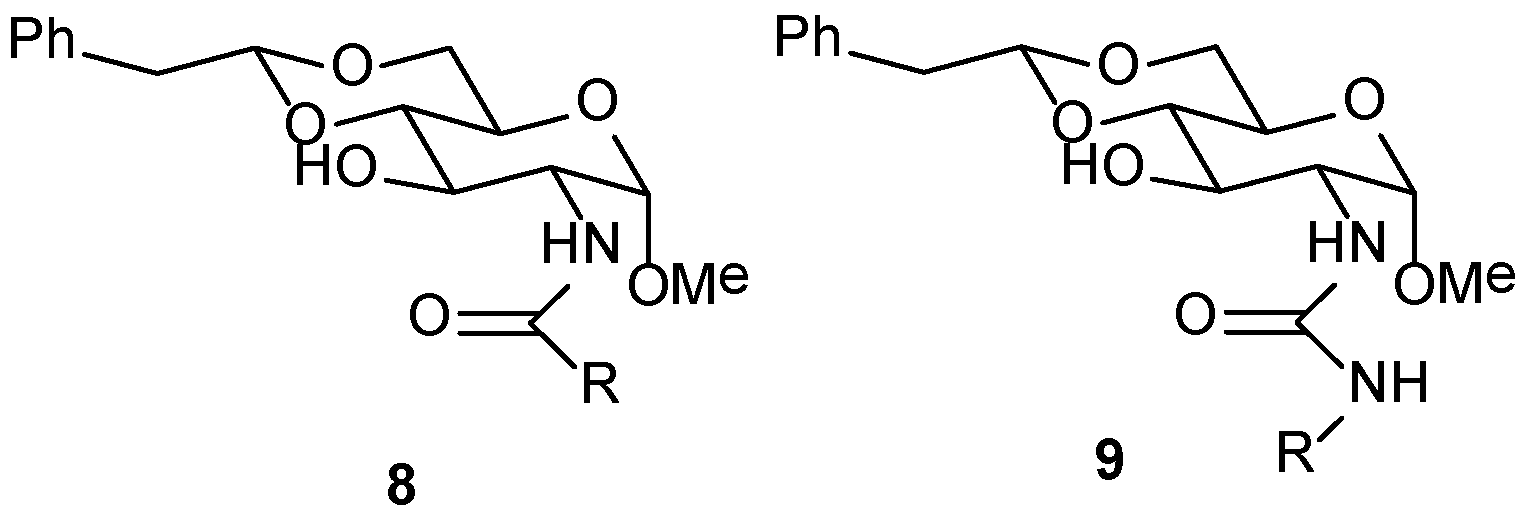

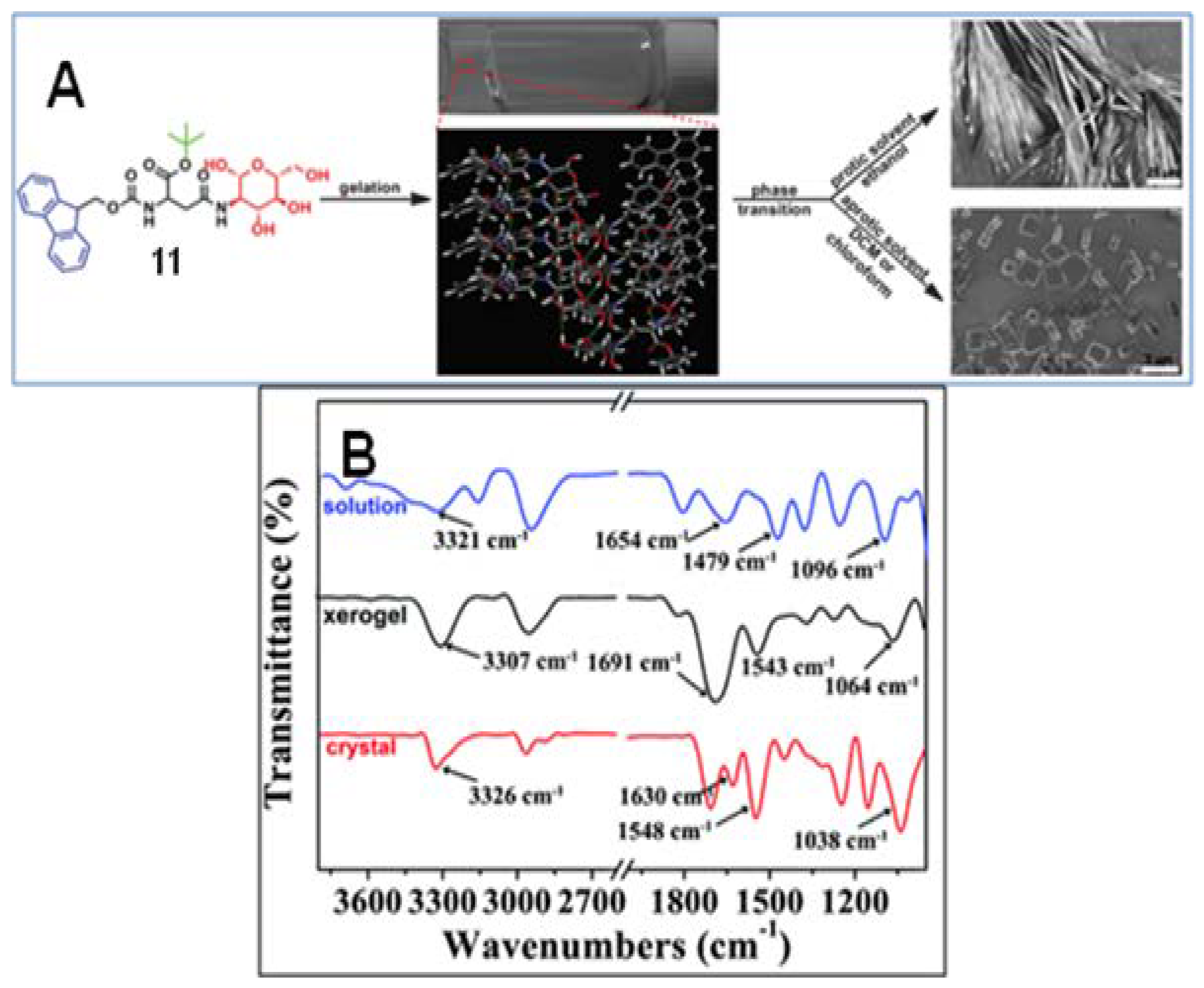

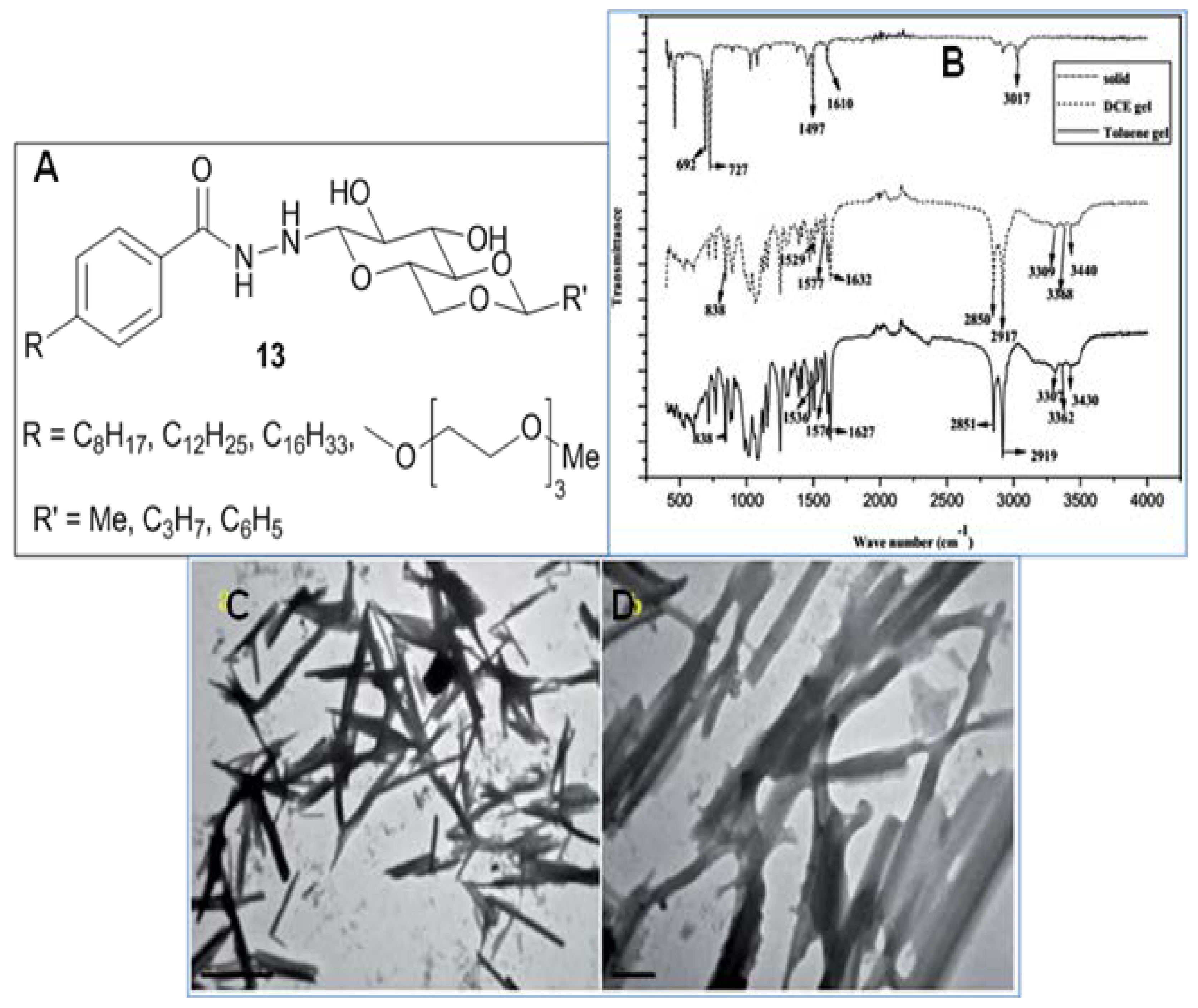
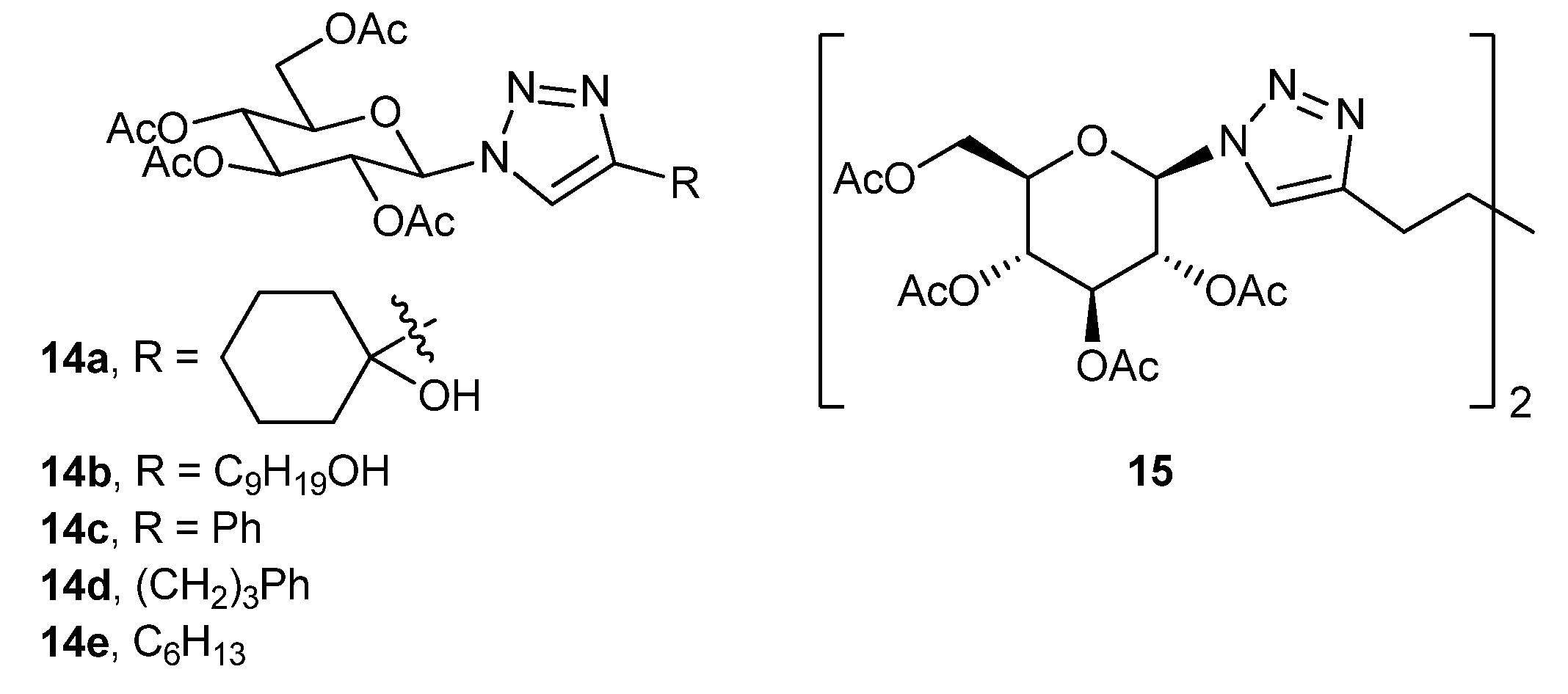
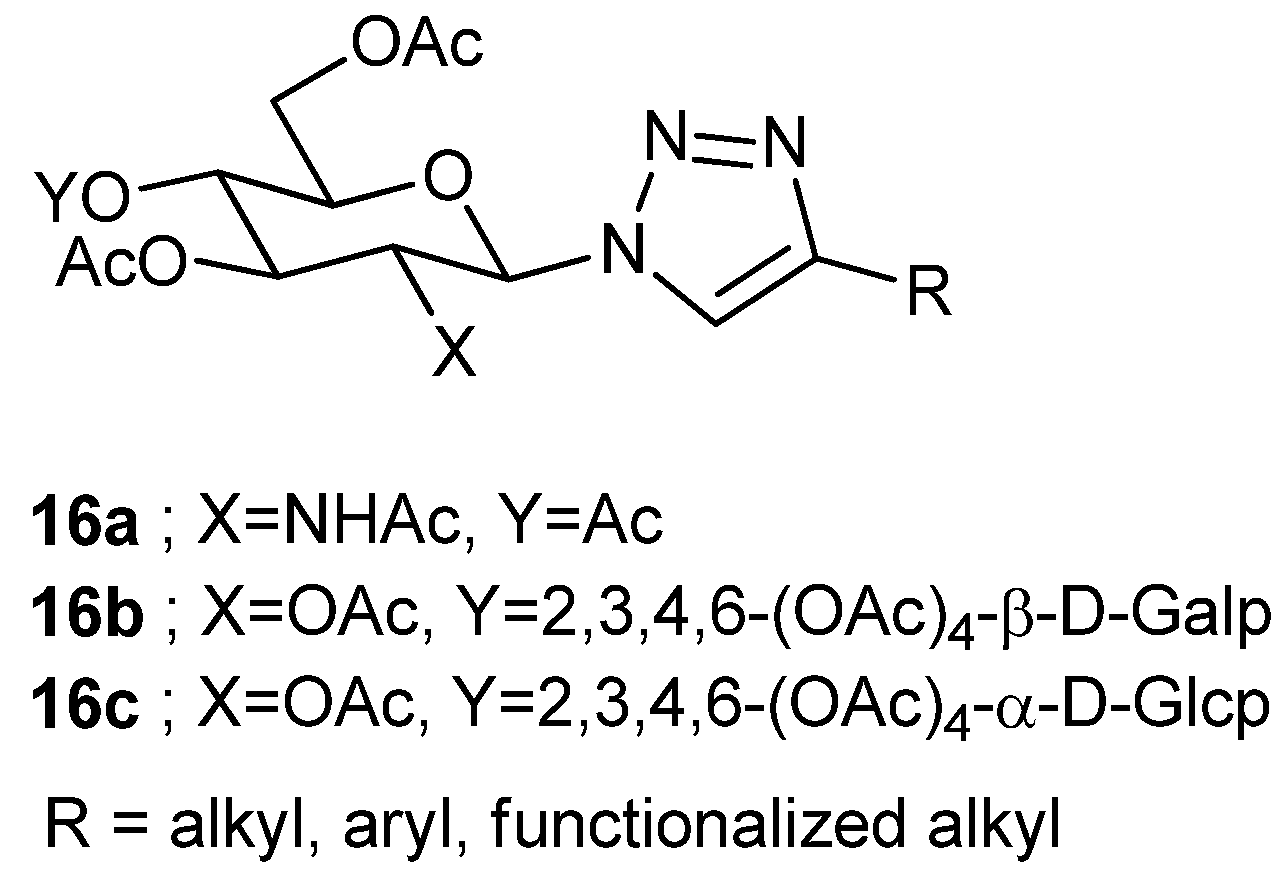
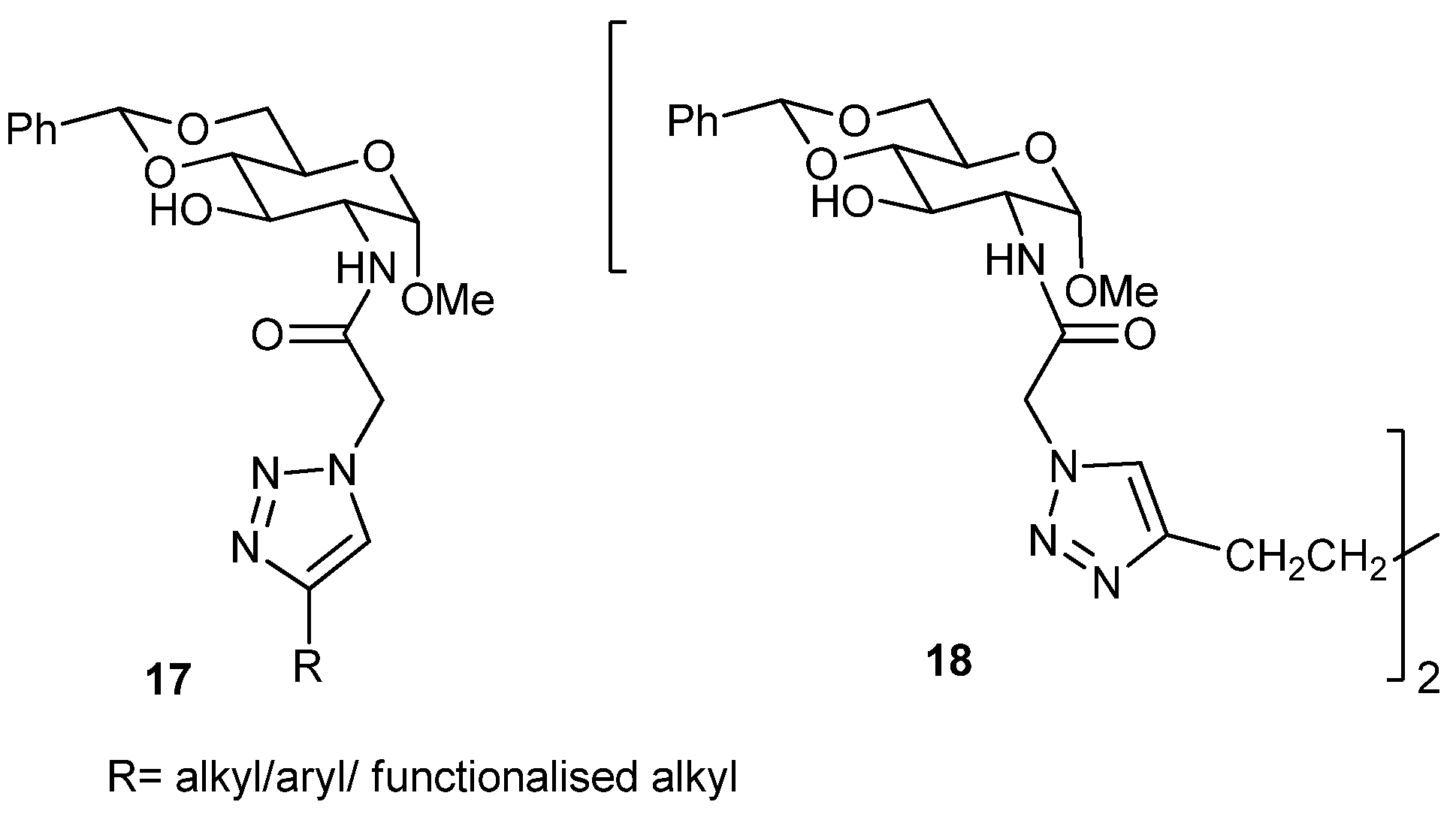




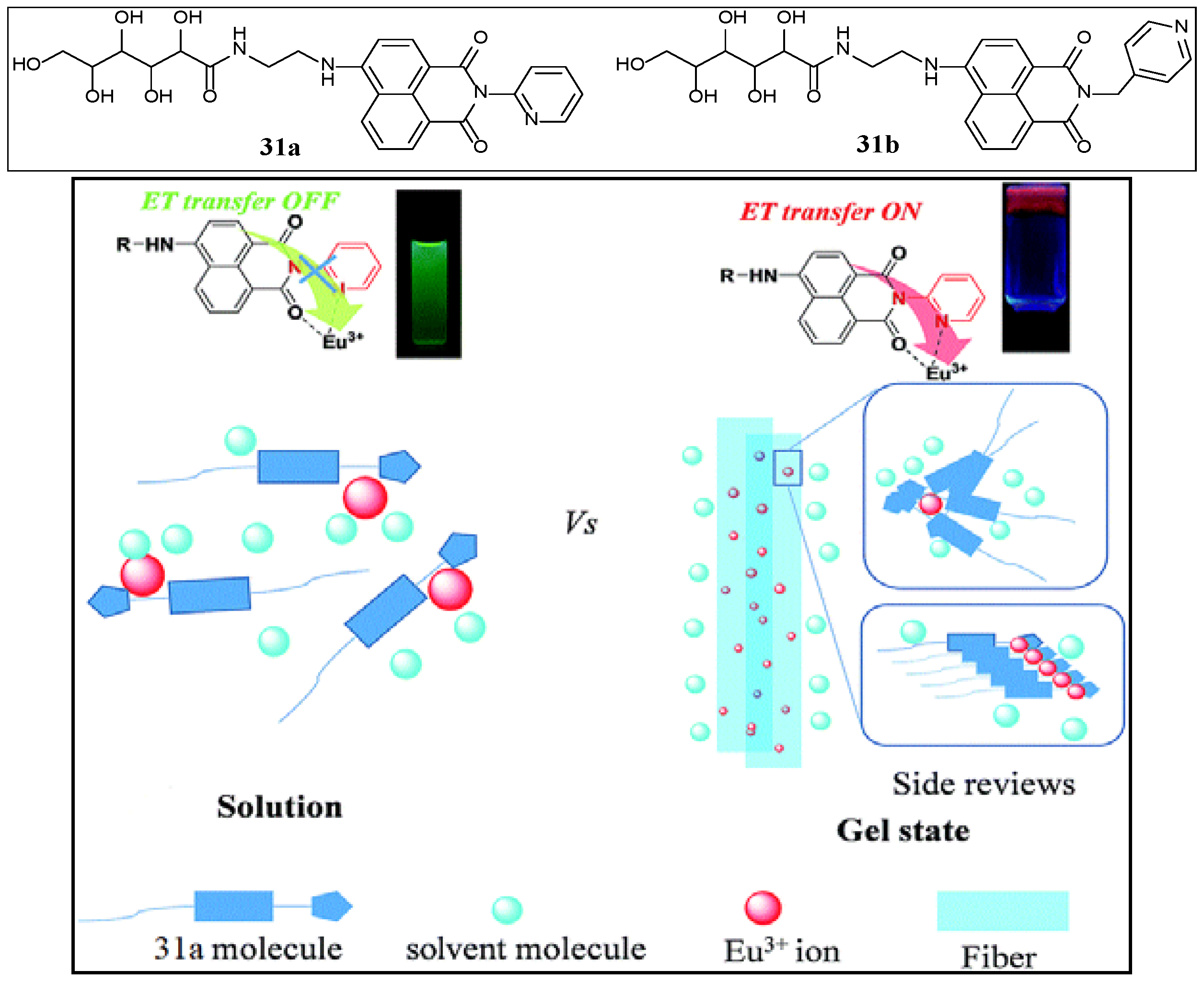
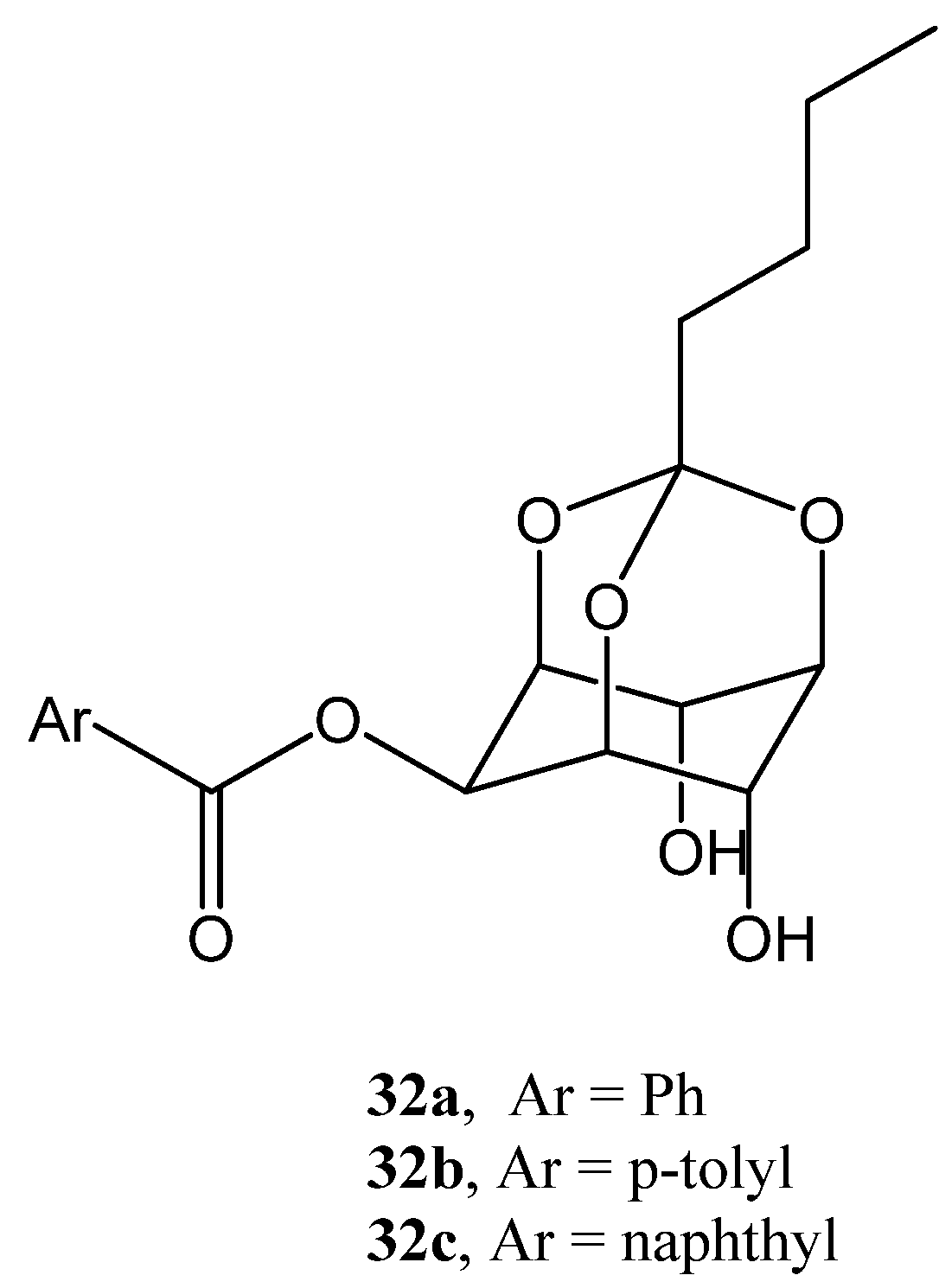
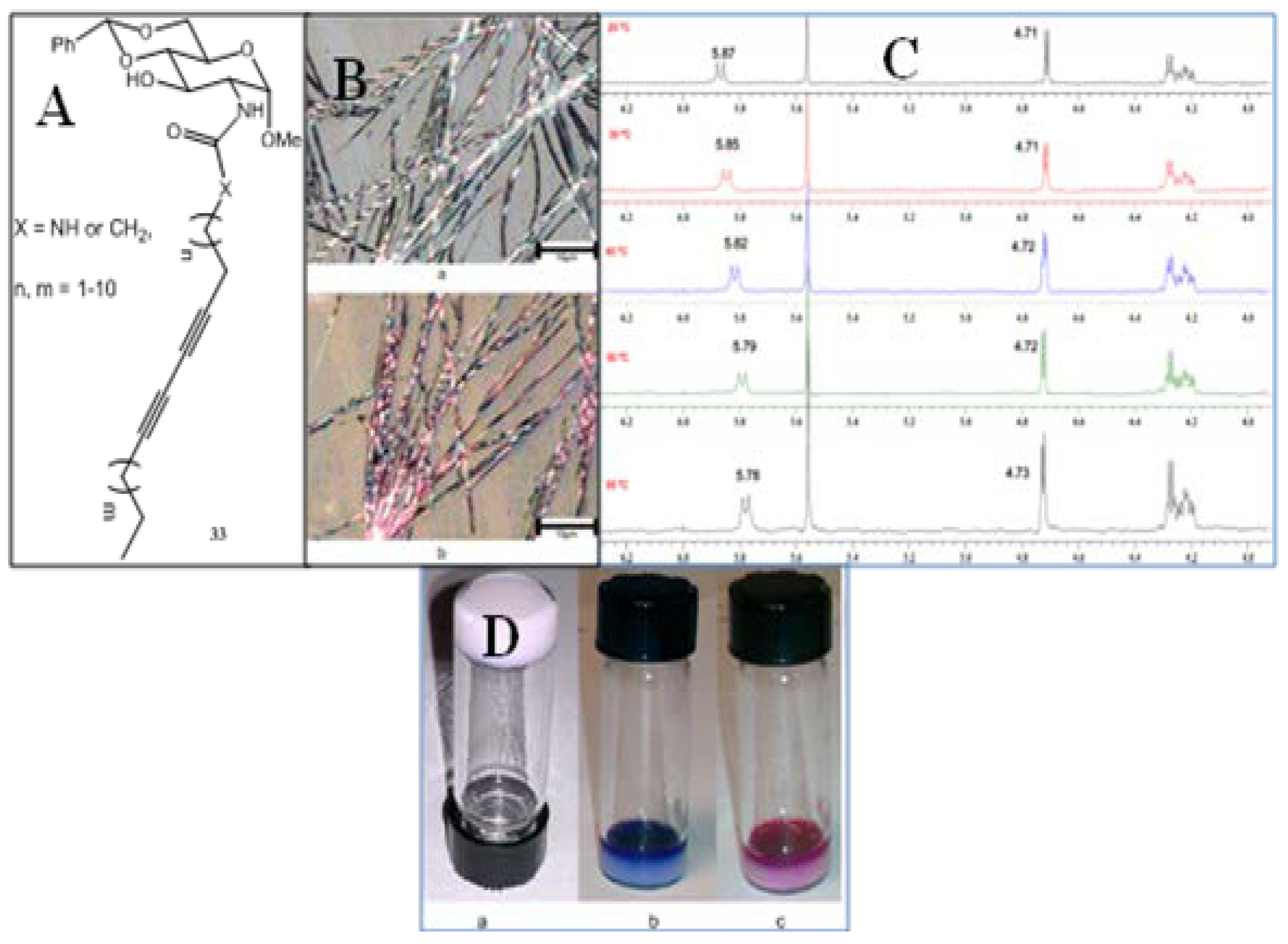


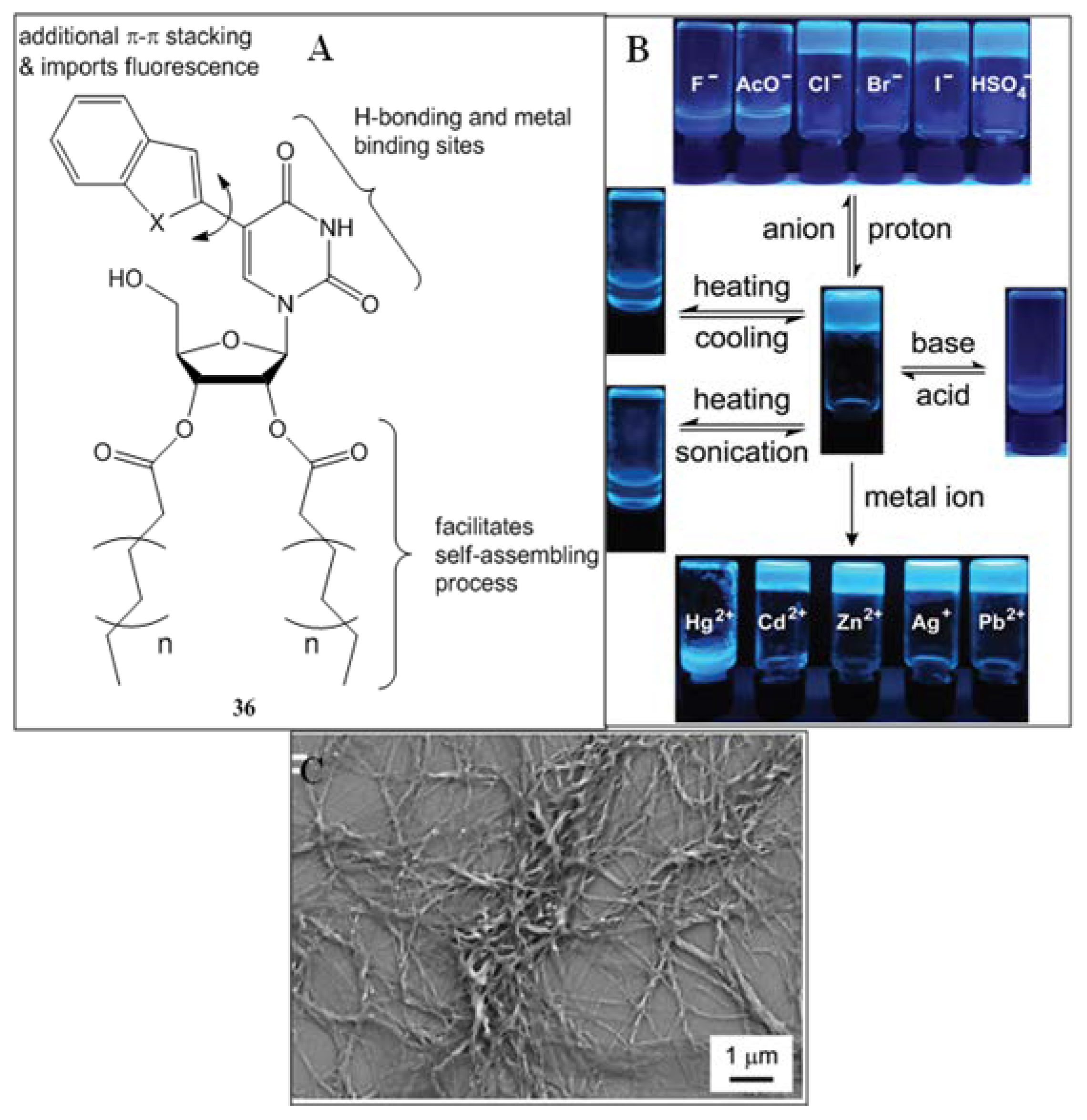

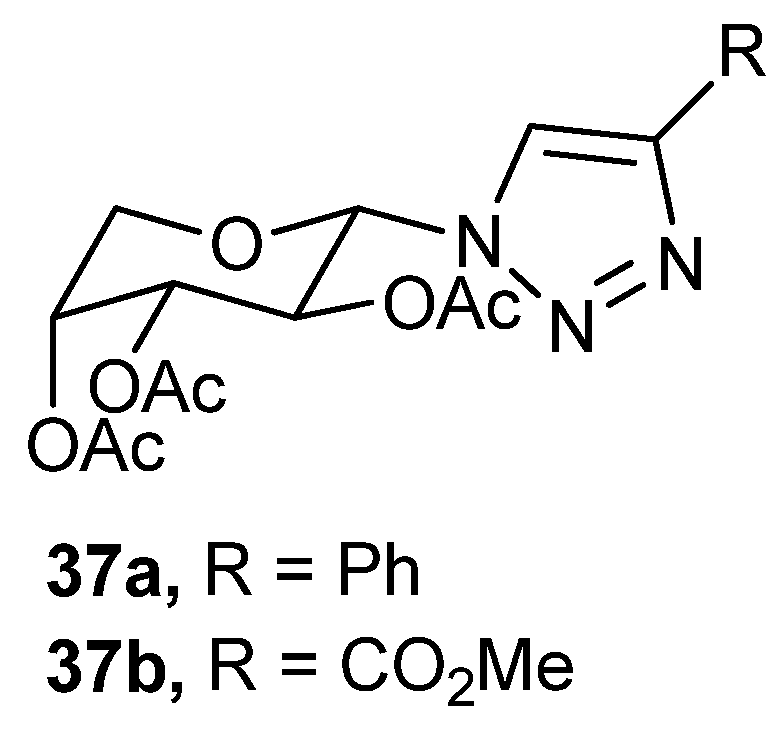


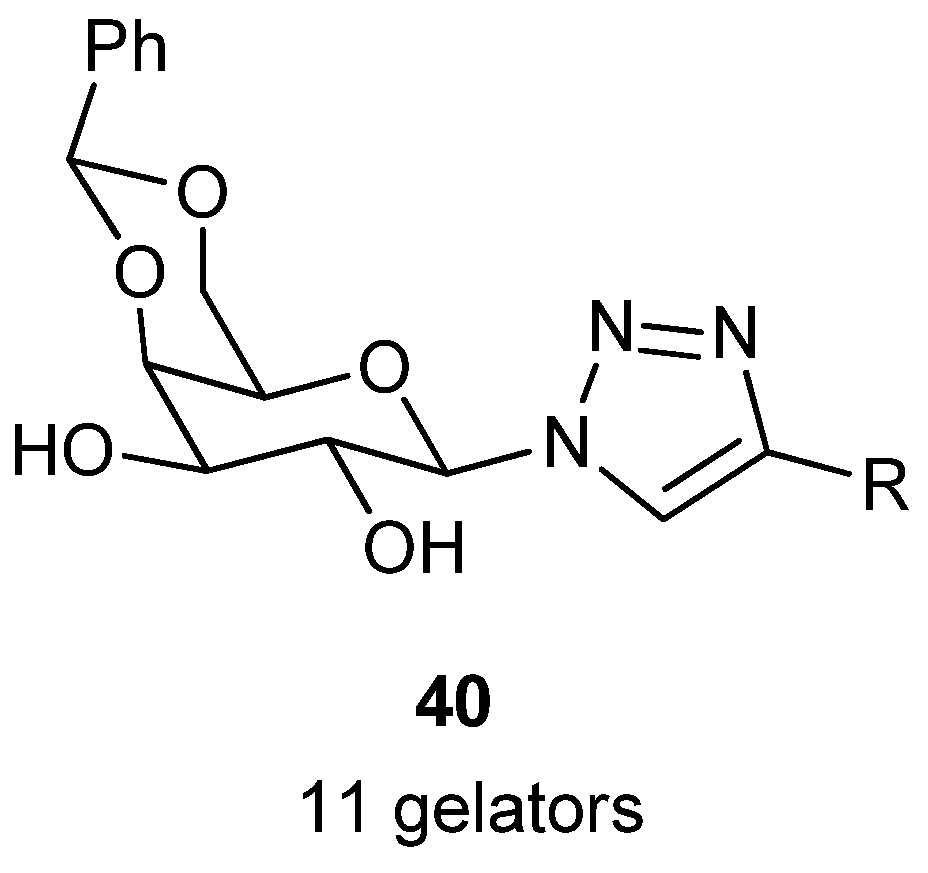
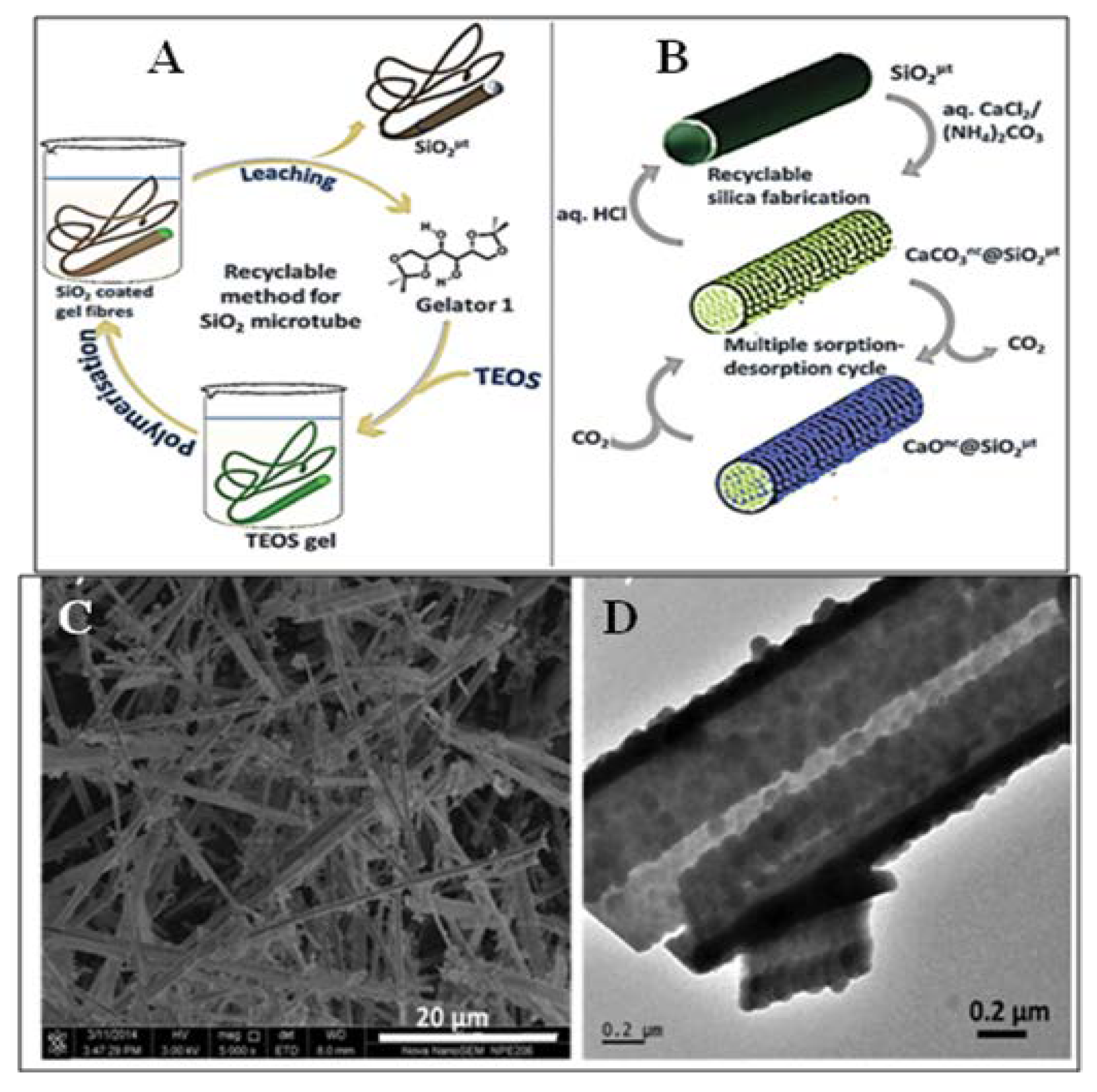
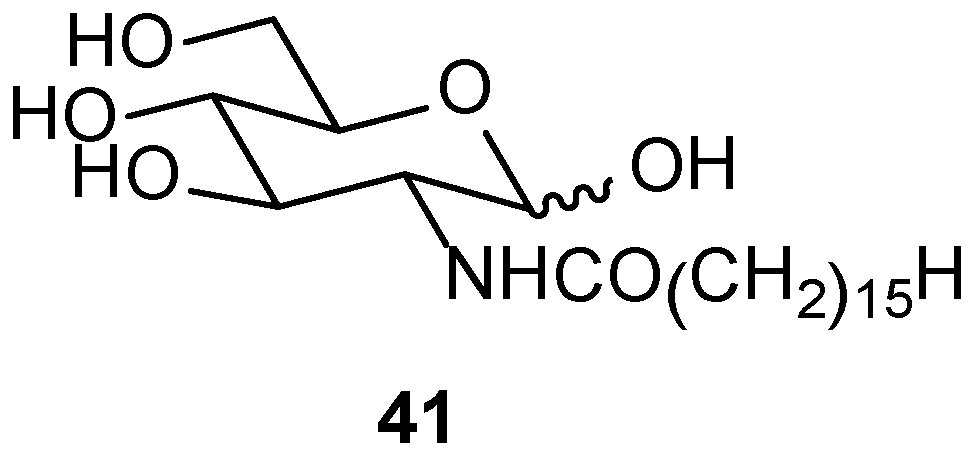




| Solvent System | MGC (% w/v) of 4a | MGC (% w/v) of 4b | MGC (% w/v) of 4c |
|---|---|---|---|
| Hexane | P | P | P |
| Octane | P | P | P |
| Dodecane | 1.8 | 1.91 | P |
| Hexadecane | 1.65 | 1.75 | 1.9 |
| Benzene | 1.16 | 1.22 | 1.43 |
| Toluene | 1.12 | 1.2 | 1.37 |
| Xylene | 1.05 | 1.2 | 1.35 |
| CRN | 1.07 | 1.28 | P |
| SRN | 1.31 | P | P |
| Kerosene | 0.62 | 1.1 | 1.84 |
| Diesel | 0.43 | 0.62 | 0.77 |
| Crude oil | 1.69 | 1.85 | 2.01 |
| Vegetable oil | 0.65 | 0.78 | 0.92 |
© 2018 by the authors. Licensee MDPI, Basel, Switzerland. This article is an open access article distributed under the terms and conditions of the Creative Commons Attribution (CC BY) license (http://creativecommons.org/licenses/by/4.0/).
Share and Cite
Basu, N.; Chakraborty, A.; Ghosh, R. Carbohydrate Derived Organogelators and the Corresponding Functional Gels Developed in Recent Time. Gels 2018, 4, 52. https://doi.org/10.3390/gels4020052
Basu N, Chakraborty A, Ghosh R. Carbohydrate Derived Organogelators and the Corresponding Functional Gels Developed in Recent Time. Gels. 2018; 4(2):52. https://doi.org/10.3390/gels4020052
Chicago/Turabian StyleBasu, Nabamita, Arijit Chakraborty, and Rina Ghosh. 2018. "Carbohydrate Derived Organogelators and the Corresponding Functional Gels Developed in Recent Time" Gels 4, no. 2: 52. https://doi.org/10.3390/gels4020052




